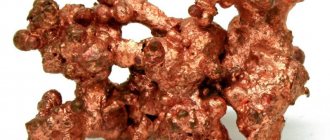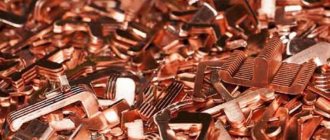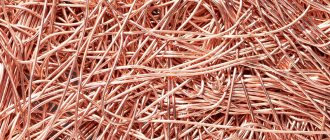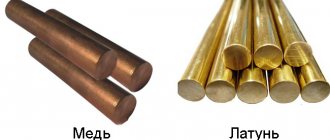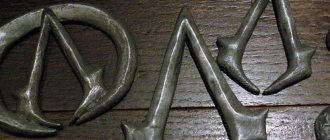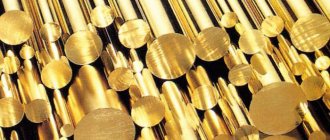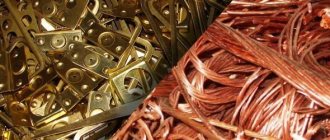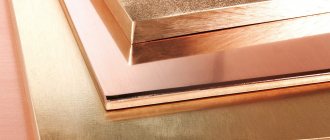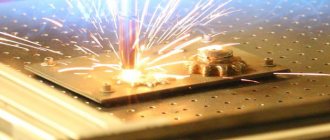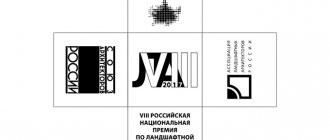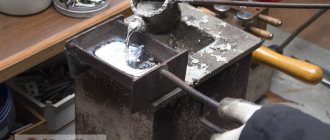Brass, which is well known and has been actively used for many years, is an alloy of copper and zinc. The inventor of this material with a number of unique characteristics is considered to be the Englishman James Emerson, who patented it in 1781.
Brass metal products have good corrosion resistance and high strength
Composition elements
The basis of brass is copper and zinc. In the most traditional composition of such an alloy, copper is contained in an amount of 70%, and zinc - 30%. There are brands of technical brass that contain 48–50 percent zinc. Typically, more than 50% of the zinc used for the production of brass alloys is obtained from waste of this metal.
Depending on the characteristics of the internal structure, alpha- and alpha-beta-type brasses are distinguished, which are also called single- and two-phase.
Their main differences are as follows.
- The chemical composition of brass alloys belonging to the alpha type contains 35% zinc.
- Alpha-beta brass (two-phase) consists of 47–50% zinc. They also contain lead, the amount of which does not exceed 6%.
Despite the fact that brass, also based on copper, is very similar in appearance to some brands of bronze, according to the professional classification it does not belong to bronze alloys. Some types of brass contain tin, the main alloying element of bronze, but it is added in very small quantities to improve certain characteristics of the alloy. In addition to tin, the chemical composition of certain brands of brass may contain elements such as lead, manganese, iron, nickel, etc., which can also improve its properties.
Content of chemical elements in simple (double) brasses (click to enlarge)
Content of chemical elements in lead brasses (click to enlarge)
Products made from brass have a beautiful golden-yellow color and are amenable to polishing and other types of machining. Depending on the grade of the alloy from which the product is made, the latter can be forged in a cold or heated state, but some types of this metal cannot be processed by plastic deformation methods. Despite the fact that brass is characterized by high corrosion resistance, the surface of products made of this metal, when exposed to the surrounding air for a long time, becomes covered with an oxide film and darkens. To prevent the surface of brass products from changing color over time, they are often coated with a protective layer of colorless varnish.
Brass
Ohm: Ohm is the resistance of a conductor through which, at a voltage of 1 V, a current of 1 Ohm = 1 V/A flows Read more: Semiconductors. Semiconductor devices
1.3. Brass
Alloys of copper and zinc, called brasses, are widely used in electrical engineering. Zinc dissolves in copper up to 39%.
In various brands of brass, the zinc content can reach up to 43%. Brasses containing up to 39% zinc have a single-phase solid solution structure and are called α-brasses. These brasses have the greatest ductility, so they are used to make parts by hot or cold rolling and drawing: sheets, strips, wire. Without heating, parts of complex configurations can be made from sheet brass using deep drawing and stamping.
Brasses with a zinc content of more than 39% are called α+β-brasses or two-phase and are used mainly for shaped castings.
Two-phase brass is harder and more brittle and can only be pressed when hot.
The addition of tin, nickel and manganese to brass increases the mechanical properties and anti-corrosion resistance, and the addition of aluminum in composition with iron, nickel and manganese gives the brass, in addition to improving the mechanical properties and corrosion resistance, high hardness. However, the presence of aluminum in brasses makes soldering difficult, and soldering with soft solders becomes almost impossible.
Due to their high ductility, brass grades L68 and L63 are easily stamped and bendable, and are easily soldered with all types of solders. In electrical engineering they are widely used for various live parts;
brass grades LS59-1 and LMTs58-2 are used for the manufacture of rotor cages of electric motors and for current-carrying parts made by cutting and hot stamping; soldered well with various solders;
LA67-2.5 brass is used for cast current-carrying parts of increased mechanical strength and hardness that do not require soft soldering;
brass LK80-3L and LS59-1L are widely used for cast current-carrying parts of electrical equipment, for brush holders and for filling the rotors of asynchronous motors. They accept soldering well with various solders.
1.4. Conducting Bronzes
Conducting bronzes belong to copper alloys, the need for their use is mainly caused by the insufficient mechanical strength and thermal stability of pure copper in some cases.
The general range of bronzes is very extensive, but only a few brands of bronzes have high electrical conductivity.
Cadmium bronze is one of the most common conductor bronzes. Of all the grades, cadmium bronze has the highest electrical conductivity. Due to its increased abrasion resistance and higher heat resistance, this bronze is widely used for the manufacture of trolley wires and collector plates;
Beryllium bronze is an alloy that gains strength through abrasion. It has high elastic properties, stable when heated to 250°C, and electrical conductivity 2 - 2.5 times greater than the conductivity of other grades of general-purpose bronzes. This bronze has found wide application for the manufacture of various spring parts that simultaneously act as a current conductor, for example: current-carrying springs, certain types of brush holders, sliding contacts in various devices, plug devices, etc.;
Phosphor bronze has high strength and good spring properties; due to its low electrical conductivity, it is used for the manufacture of spring parts with low current densities.
Cast current-carrying parts are made from various grades of machine-building cast bronzes with conductivity within 8-15% of the conductivity of pure copper. A characteristic feature of bronzes is low shrinkage compared to cast iron and steel and high casting properties, therefore they are used for casting various current-carrying parts of complex configurations intended for electrical machines and apparatus.
All brands of cast bronzes can be divided into tin and tin-free, where the main alloying elements are Al, Mn, Fe, Pb, Ni.
1.6. Aluminum
The characteristic properties of pure aluminum are its low specific gravity, low melting point, high thermal and electrical conductivity, high ductility, very high latent heat of fusion and a durable, although very thin, oxide film covering the surface of the metal and protecting it from the penetration of oxygen inside.
Good electrical conductivity ensures the widespread use of aluminum in electrical engineering. Since the density of aluminum is 3.3 times lower than that of copper, and the resistivity is only 1.7 times higher than that of copper, then aluminum per unit mass has twice the conductivity of copper.
Sulfur dioxide, hydrogen sulfide, ammonia and other gases found in the air of industrial areas do not have a noticeable effect on the corrosion rate of aluminum. The effect of water vapor on aluminum is also insignificant. In contact with most metals and alloys that are noble in the electrochemical potential range, aluminum serves as an anode and, therefore, its corrosion in electrolytes will progress.
To avoid the formation of galvanic couples in a humid atmosphere, the junction of aluminum with other metals is sealed by varnishing or other means.
Long-term tests of aluminum wires have shown that they are not inferior to copper wires in terms of resistance to corrosion.
Table 1.2. Main characteristics of conductor materials
| Material | Density, Kg/m³٠10³ | Temperature melting point, °C | Specific electrical resistance at 20°C, Ohm٠m٠10ˉ | Average temperature Resistance coefficient from 0 to 100°C, 1/deg | Note |
| Aluminum | 2,7 | 660 | 0,026–0,028 | 4∙10־³ | Wires, cables, tires, conductors of squirrel-cage rotors, housings and bearing shields of small electrical machines |
| Bronze | 8,3–8,9 | 885–1050 | 0,021–0,052 | 4∙10־³ | Cadmium bronze – contacts, phosphor bronze – springs |
| Brass | 8,4–8,7 | 900–960 | 0,03–0,08 | 2∙10־³ | Contacts, clamps |
| Copper | 8,7–8,9 | 1080 | 0,0175–0,0182 | 3∙10־² | Wires, cables, tires |
| Tin | 7,3 | 232 | 0,114–0,120 | 4,4∙10־³ | Solders for tinning and soldering in an alloy with lead |
Ohm: Ohm is the resistance of a conductor through which, at a voltage of 1 V, a current of 1 Ohm = 1 V/A flows Read more: Semiconductors. Semiconductor devices
Information about the work “Conductors, semiconductors and dielectrics”
Section: Physics Number of characters with spaces: 57947 Number of tables: 2 Number of images: 9
Similar works
Quantum yield of light-sensitive semiconductor-metal-dielectric structures
29489
0
6
..., no need to determine the thickness and resistivity of the metal layer, reducing the number of operations for processing the results. Claim of invention Method for determining efficiency photosensitive semiconductor-metal systems, including sequential deposition of a metal layer (in the form of a snake) 200 nm thick, a diiodide layer...
Crystals in nature
169673
2
43
... we must keep in mind the possibility of structural features of time for each of these types. II Interaction forces and the structure of crystals 2.1. The nature of binding forces in crystals. Different types of crystals and the possible location of nodes (the point around which an atom (molecule) vibrates) in a spatial lattice...
Electrical materials
26450
0
4
... types of processing in the manufacture of necessary products from them. Therefore, different materials have to be selected for different applications. Electrical insulating materials form the most numerous section of electrical materials in general; the number of individual types of specific electrical insulating materials used in the modern electrical industry amounts to many thousands...
Lectures on solid-state electronics
193480
0
0
... relevant computer programs. Similarly, for n of type n>>p For p, the following equations will correspondingly take place: (1.69)Voronkov E.N. Solid State Electronics. 2002 Contents Lecture 6 67 2. DIODES. 67 2.1. Semiconductor diodes with electron-hole junction (pn junction). 67 2.2. Electron-hole transition (pn – transition). The emergence...
Chemical composition and features of the internal structure
To have a good understanding of the characteristics of brass, it is important to understand what properties the chemical elements of which it is composed have. Such elements, as mentioned above, are copper and zinc.
Classification of brasses by chemical composition
Copper is one of the first metals that man began to use for the manufacture of products for various purposes. This element, which is included in the 11th group of the IV period of the periodic table, has atomic number 29 and is designated as Cu (short for Cuprum). Copper, which is a transition metal, is highly ductile and has a beautiful light golden color. When an oxide film forms, the metal acquires an equally beautiful yellowish-red hue.
Zinc, the second main element in the chemical composition of brass, is also a metal that, unlike copper, does not occur in nature in its pure form. Zinc, having atomic number 30, is included in the secondary subgroup of the 2nd group of the IV period of the periodic table. This metal, which began to be produced in the 12th century in India, is highly brittle under normal conditions. Without the oxide film that appears on the metal when it interacts with open air, its surface has a light blue color. This metal is designated by the symbol Zn (short for Zincum).
This is what the microstructure of a polished brass surface looks like under 400x magnification.
The structure of brass, depending on the content of the main components in its composition, can consist of one α-phase or simultaneously α+β-phases. The states that the internal structure of the alloy can assume are distinguished by the following features:
- α-phase is a solution of copper and zinc, characterized by high stability, in which the molecules of the base metal (copper) have a face-centered cubic lattice;
- The α+β phase is also a stable solution in which copper and zinc are contained in a ratio of 3:2 (in such a solution, copper molecules have a simple unit cell).
The microstructure of α + β-brass has less ductility and greater hardness than the structure of α-brass
Depending on the heating temperature, the following structural transformations occur in brass.
- When brass is heated to high temperatures, the atoms in its β-phase, which has a wide range of homogeneity, are characterized by a disordered arrangement. In this heating state, the β-phase of the brass alloy is highly ductile.
- When a brass alloy is slightly heated (454–468 °
), a phase designated β' is formed in it. A feature of this structural phase, which is characterized by high hardness and, accordingly, brittleness, is that the copper and zinc atoms in it are arranged in an orderly manner.
Based on the foregoing, we can conclude that brass alloys, the internal structure of which is only the α-phase (single-phase), are distinguished by good ductility, and those in which the β-phase is also present (two-phase) are more durable, but not intended for processing by plastic deformation methods.
The ductility of brasses with a two-phase structure can be increased if they are heated above the temperature at which the β'-transformation occurs (700°
).
In this state, only one β-phase predominates in the structure of the alloy; accordingly, it is characterized by high plasticity. However, even single-phase brasses with good ductility can practically not be processed by plastic deformation methods. This occurs in the temperature range of their heating to 300–700 °
, which is called the brittleness zone.
The zinc content in brass affects the electrical conductivity of the alloy
The mechanical properties of brass of a particular grade are significantly influenced by the zinc content in its chemical composition. So, if the content of this chemical element is up to 30%, then both the strength and ductility of the alloy increase at the same time. A further increase in the zinc content leads to the fact that brass becomes less ductile (complication of the α-phase), and then more brittle (formation of the β'-phase in the brass structure). The strength of brass increases until its composition contains 45% zinc; with a further increase in the amount of this element, brass becomes both less strong and less ductile.
Production methods
A copper alloy such as brass lends itself well to various processing methods. Thus, various products can be produced from this alloy using forging, stamping and drawing methods, and due to its relatively low melting point and good fluidity in the molten state, it is actively used in foundries.
Pouring molten brass into molds
Brass, the main alloying element in which is zinc, is obtained by melting:
- in crucibles made of refractory material (for heating, crucibles together with alloy components are placed in shaft or flame furnaces);
- in reverberatory furnaces (when using this method, smelting is performed without the use of crucibles).
When smelting a brass alloy, one should take into account the fact that zinc will actively evaporate during this procedure, so the amount of this metal should be calculated with some margin.
Physical representation
In technical calculations involving the laying of cables of various diameters, parameters are used to calculate the required cable length and its electrical characteristics. One of the main parameters is resistivity. Electrical resistivity formula:
ρ = R * S / l, where:
- ρ is the resistivity of the material;
- R is the ohmic electrical resistance of a particular conductor;
- S—cross section;
- l - length.
The dimension ρ is measured in Ohm•mm2/m, or, to shorten the formula - Ohm•m.
The value of ρ for the same substance is always the same. Therefore, this is a constant characterizing the material of the conductor. It is usually indicated in directories. Based on this, it is already possible to calculate technical quantities.
It is important to say about specific electrical conductivity. This value is the inverse of the resistivity of the material, and is used equally with it. It is also called electrical conductivity. The higher this value, the better the metal conducts current. For example, the conductivity of copper is 58.14 m/(Ohm•mm2). Or, in SI units: 58,140,000 S/m. (Siemens per meter is the SI unit of electrical conductivity).
